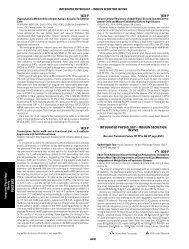Urinary Adiponectin Excretion: A Novel Marker for ... - Diabetes
Urinary Adiponectin Excretion: A Novel Marker for ... - Diabetes
Urinary Adiponectin Excretion: A Novel Marker for ... - Diabetes
Create successful ePaper yourself
Turn your PDF publications into a flip-book with our unique Google optimized e-Paper software.
UKPDS risk engine was previously<br />
introduced as a parametric model that<br />
provides the estimates of primary CHD risk in<br />
type 2 diabetes (19). In contrast to previous<br />
models <strong>for</strong> CHD, such as the Framingham<br />
risk equations, the diabetes-specific approach<br />
of the UKPDS risk engine includes HbA1c as<br />
continuous variable. Age as a risk factor is<br />
replaced by two diabetes-specific variables:<br />
age at diagnosis of type 2 diabetes and time<br />
since diagnosis. Furthermore, as there is<br />
evidence that diabetic dyslipidemia is<br />
qualitatively different from dyslipidemia in<br />
the general population, total- and HDLcholesterol<br />
are included instead of LDLcholesterol.<br />
The complete model incorporates:<br />
age at diagnosis of diabetes, diabetes<br />
duration, sex, smoking status, HbA1c values,<br />
systolic blood pressure, and the total/HDLcholesterol<br />
ratio (19). We thus plotted ROC<br />
curves and the area under the curve (AUC)<br />
was analyzed to study the value of the<br />
‘UKPDS CHD risk engine’ <strong>for</strong> the prediction<br />
of carotid atherosclerosis (upper vs. lower two<br />
tertiles of IMT). Calculations were per<strong>for</strong>med<br />
by online provided software<br />
[http//:www.dtu.ox.ac.uk]), Intertertile cutoff<br />
points of IMT were 0.94 mm (n=52).<br />
Values <strong>for</strong> the AUC as obtained by the<br />
UKPDS risk engine were compared with the<br />
AUC after additional inclusion of AER and<br />
urinary adiponectin. Statistical comparisons of<br />
the AUC ROC curves were per<strong>for</strong>med using<br />
'roccomp' command provided by the<br />
statistical software Stata/SE 8.2 <strong>for</strong> Windows<br />
(Stata Corporation, Texas, USA). A p value<br />
less than 0.05 was considered to be<br />
statistically significant.<br />
RESULTS<br />
Immunohistochemistry of<br />
adiponectin in human kidneys and<br />
determination of urinary adiponectin<br />
iso<strong>for</strong>ms by western blot: A strong staining<br />
<strong>for</strong> adiponectin was detected on the<br />
6<br />
<strong>Urinary</strong> adiponectin in type 2 diabetes<br />
endothelium of intrarenal arteries/arterioles,<br />
and on the endothelial surface of glomerular<br />
and peritubular capillaries in all non-diabetic<br />
kidneys and representive findings are shown<br />
in Figure 1A. In patients with early diabetic<br />
nephropathy, the homogeneous glomerular<br />
staining pattern of adiponectin was markedly<br />
decreased, whereas adiponectin staining in<br />
intrarenal arteries/arterioles remained<br />
unchanged (Figure 1B). Moreover, in T2DM<br />
kidney biopsies, adiponectin was found in<br />
tubular casts, indicating urinary excretion of<br />
the protein (Figure 1C). In patients at<br />
advanced stages of diabetic nephropathy with<br />
overt glomerulosclerosis, glomerular staining<br />
<strong>for</strong> adiponectin was almost completely lost<br />
(not shown).<br />
We next studied whether adiponectin<br />
is specifically detectable in urine of patients<br />
with diabetic nephropathy and either current<br />
normoalbuminuria or microalbuminuria, and<br />
healthy controls and whether different<br />
iso<strong>for</strong>ms of adiponectin are present in these<br />
samples. In western blot analyses of urine<br />
samples from patients with diabetic<br />
nephropathy the strongest signals were found<br />
at ~75kDa, most likely representing the LMW<br />
adiponectin trimer (68kDa). An additional<br />
signal at ~25kDa represents the adiponectin<br />
monomer (28kDa) (Figure 1 D) as previously<br />
shown <strong>for</strong> serum adiponectin (17). In healthy<br />
controls antigens representing adiponectin<br />
dimers (56 kDa) and monomers were found,<br />
however, overall intensity of these signals<br />
was much lower compared to the diabetes<br />
patients studied (Figure 1 D).<br />
Association of serum and urinary<br />
adiponectin levels with cardiovascular risk<br />
factors: Characteristics of control subjects<br />
and patients with T2DM and bivariate<br />
analyses of associations between different<br />
variables and serum or urinary adiponectin<br />
shown in Table 1. Serum adiponectin was<br />
significantly lower, and urinary adiponectin<br />
levels significantly higher in patients with<br />
T2DM than in control subjects (mean serum
















